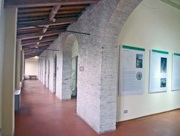
This series of rooms on the right at the end of the corridor through the Prehistoric and Bronze Age Collection, which was originally part of the dormitory of the convent, now houses a collection of artefacts from the most important cities of Roman Umbria.
The description below pre-dates a re-organisation of this part of the museum: none of these exhibits were exhibited here during my visit in June 2017. Some have been relocated and others are (hopefully temporarily) no longer exhibited.
Bettona
Inscriptions of the Sexti Valerii (early 1st century AD)
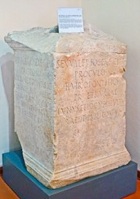
-
✴The first inscription (AE 1996 635a) commemorates Sextus Valerius Capitoni, son of Sextus, who had been: a military tribune; pontifex (municipal priest of the imperial cult); and aedile.
-
✴The second inscription (AE 1996, 635b) reads:
SEX. VALERIO SEX. F. CLV.
PROCVLO
IIVIRO PONTIFICI
PR. ETRVRIAE
FVNVS ET LOCVS SEPVLTV
RAE D.D. PVBLIC. DATVS
-
It commemorates Sextus Valerius Proculus, son of Sextus, who had been: duovir; pontifex (municipal priest of the imperial cult); and praetor Etruriae.
Bevagna
Architectural Terracottas (2nd century BC)
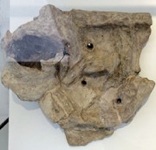
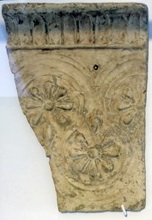
These reliefs, which were found in 2005 at the sanctuary at the Laghetto dell’ Aisillo, to the north of Bevagna, attest to its monumentalisation in the 2nd century BC.
Grave goods from Pilone di Bevagna (ca. 100 AD)
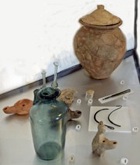
Carsulae
Portrait Busts (1st century AD)
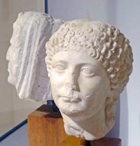
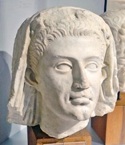
These apparently undocumented marble busts portray
-
✴a young woman; and
-
✴a man crowned with laurels, who also sports a veil.
Città di Castello
Tabula Tifernas Tiberina (19 AD)
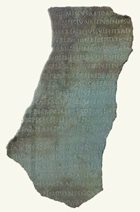
This fragment is complimented by a similar inscription, the Tabula Siarensis, which was discovered near Seville in 1982, so that some of the lacunae in each of them can be filled by the other.
Gubbio
Grave Goods from Via Perugina (1st century AD)
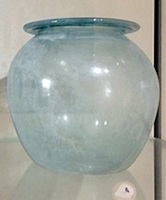
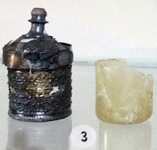
These grave goods in showcase 3 came from Tomb 6 of the small necropolis at Via Perugina (see Walk II), near the confluence of the Camignano and Cavarello torrents. They include:
-
✴a glass funerary urn; and
-
✴an ink pot made up of a glass inner part and a gilded silver outer cover.
Grave Goods from Via Vittorina (1st and 2nd centuries AD)
Some of the grave goods in showcase 3 came from a grave in the Vittorina necropolis, which was discovered in 1980 during earthworks for the construction of the new headquarters of a cement company, Collacem Spa (60 Viale Vittorina - see Walk II). Excavations in 1980-2 uncovered some 237 tombs, mostly from the period 1st century BC - 2nd century AD. Other finds from these excavations are exhibited in the Antiquarium, Gubbio.
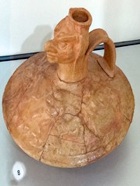
-
✴an oil lamp made by the workshop of Lucius Caius Caerius;
-
✴bone needles and a glass bead from a necklace;
-
✴three Roman coins:
-
•a bronze “quadrans” (coins, literally quarters), possibly from the year of the consul C. Cassius Longinus (126 BC), with a head of Hercules on the front and the prow of a ship on the back;
-
•a bronze “as” (small coin), with the head of the Emperor Trajan (98-117 AD) on the front and a personification of Rome with a prisoner on the back; and
-
•an “aes” (bronze cast coin), probably from the period of the Emperor Trajan; and
-
✴a “lagoena” (vase) with anthropomorphic neck (ca. 200 AD), which was decorated with circus scenes (illustrated here).
Otricoli
Marble Relied (1st century AD)
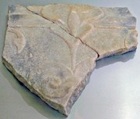
Marble Funerary Vase (ca. 100 AD)
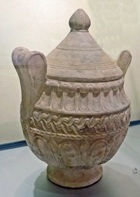
Bronze sandal (1st century AD)
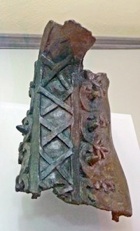
Spello
Head of a boy (1st century AD)
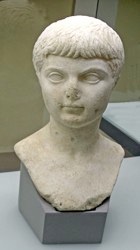
Walk back towards the corridor containing the Prehistoric and Bronze Age Collection and turn right just beyond it to see the Cippus of Perugia.
Return to the main page on the Museo Archeologico.



